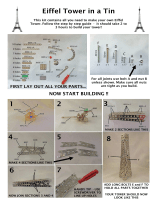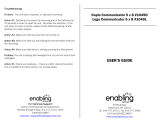
1
21031
BurjKhalifa
Dubai, United Arab Emirates

2
Burj Khalifa
Describedasbotha‘VerticalCity’and‘ALivingWonder’BurjKhalifa
attheheartofdowntownDubaiisalsotheworld’stallestbuilding
DevelopedbyDubai-basedEmaarPropertiesPJSCBurjKhalifarises
gracefullyfromthedesertandhonorsthecitywithitsextraordinary
unionofartengineeringandmeticulouscraftsmanship
Atftmtheequivalentofa-storybuildingBurjKhalifa
hashabitablelevelsthemostofanybuildingintheworldThe
towerwasinauguratedonJanuarytocoincidewiththefourth
anniversaryoftheAccessionDayofHisHighnessSheikhMohammed
BinRashidAlMaktoumVicePresidentandPrimeMinisteroftheUAE
andRulerofDubai
Arguablytheworld’smostinterestingconstructionprojectBurjKhalifa
isresponsibleforanumberofworldfirstsThetowerbecamethe
world’stallestman-madestructurejustdaysafterexcavation
workstartedinJanuary

3
© Emaar Properties PJSC

4
© Emaar Properties PJSC © Emaar Properties PJSC
Burj Khalifa utilized a record-breaking 430,000 cubic yds. (330,000 m
3
)
of concrete; 42,990 tons (39,000 metric tons) of steel reinforcement;
1.1 million sq. ft. (103,000 m
2
) of glass; and 167,000 sq. ft. (15,500 m
2
) of
embossed stainless steel. The tower took 22 million man-hours to build.
With a total built-up area of 5.67 million sq. ft. (526,000 m
2
), Burj Khalifa
features 1.85 million sq. ft. (170,000 m
2
) of residential space, over 300,000
sq. ft. (28,000 m
2
) of office space, with the remaining area occupied by
a luxury hotel. In 2003, as a result of an international design
competition, Skidmore, Owings & Merrill LLP (SOM) was selected from
a group of five international competitors to carry out the architecture
and engineering of the Burj Khalifa.
With famous architecture in the Haj Terminal at Jeddah Airport and
National Commercial Bank, SOM is no stranger to Middle Eastern
design. SOM incorporated patterns and elements from traditional Islamic
architecture, but the most inspiring muse was a regional desert flower,
the Hymenocallis, whose harmonious structure is one of the organizing
principles of the tower’s design. Three ‘petals’ are arranged in a triangular

5
shapeandunifiedatthecenterandinsteadofrepeatedidentical
patternsthearchitecturalplanappointssuccessivelyrecedingand
rotatedstories
TheY-shapedplanisidealforresidentialandhotelusagewiththe
wingsallowingmaximumoutwardviewsandinwardnaturallightViewed
fromaboveorfromthebasethetipsoftheY-shapedplanevoke
theoniondomesofIslamicarchitectureDuringthedesignprocess
engineersrotatedthebuildingdegreesfromitsoriginallayoutto
reducestressfromprevailingwinds
Architecturallythebuildingtransformsitselffromasolidbaseexpression
toaverticallyexpressedmiddlesectionofpolishedstainlesssteel
projectedmetalfinsandglassOnlyverticalelementswereused
hereasthefinedustinDubai’sairwouldbuilduponanyhorizontal
projectingelements
DESERT FLOWER
DOME SHAPE
© Emaar Properties PJSC© Emaar Properties PJSC
© Emaar Properties PJSC© Emaar Properties PJSC

6
WiththedesignandengineeringofBurjKhalifaSkidmoreOwings&
MerrillLLPSOMjoinedforceswithDubaibaseddevelopersEmaar
PropertiesPJSCtoredefinewhatwaspossiblewithsupertallbuildings
Withaportfoliothatincludessomeofthemostimportantarchitectural
accomplishmentsofthethandstcenturiesincludingtheJohn
HancockCenterandWillisformerlySearsTowerSOMwasperfectly
placedtocarryoutthischallengingtask
TocreateBurjKhalifa—abuildingthatshattersallpreviousheightrecords
atftm—ateamofmorethandesignersandengineers
combinedcuttingedgetechnologyandculturally-influenceddesignto
createaglobaliconthatwillserveasamodelforfutureurbancenters
The Architects
© Emaar Properties PJSC

7
Construction Highlights
©EmaarPropertiesPJSC
Burj Khalifa is truly the product of international collaboration; over 60
consultants including 30 on-site contracting companies from around
the world were involved in the project.
At the peak of construction, over 12,000 professionals and skilled
workers from more than 100 countries were on site every day. The
world’s fastest high-capacity construction hoists, with a speed of up
to 6.5 ft./sec (2 m/sec or 120 m/min), were used to move men and
materials.
Over 1.59 million cubic ft. (45,000 m
3
) of
concrete, weighing more than 121,254
tons (110,000 metric tons), were used
to construct the concrete and steel
foundations, which feature 192 piles,
buried more than 164 ft. (50 m) deep.
Burj Khalifa employs a record-breaking
11.6 million cubic ft. (330,000 m
3
) of
concrete; 42,990 tons (39,000 metric
tons) of reinforced steel; 1.1 million sq.
ft. (103,000 m
2
) of glass; 166,800 sq. ft.
(15,500 m
2
) of embossed stainless steel;
and the tower took 22 million man-hours
to build. The amount of reinforced steel
used at the tower would, if laid end to
end, extend over a quarter of the way
around the world. The concrete used
is equivalent to a sidewalk 1,200 miles
(1,900 km) in length, and the weight of
110,000 elephants. The weight of the
empty building is 551,156 tons (500,000
metric tons).
The tower accomplished a world record for the highest installation of
an aluminum and glass facade, at a height of 1,679.8 ft. (512 m). The
total weight of aluminum used on Burj Khalifa is equivalent to that
of five A380 aircraft, and the total length of stainless steel ‘bull nose’
fins is 293 times the height of the Eiffel Tower in Paris.

8
Facts about Burj Khalifa
Location .......................... DowntownDubaiDubaiUnitedArabEmirates
Architect .........................SkidmoreOwings&MerrillLLPSOM
Buildingtype ...............Supertallskyscraper
Materials .........................Reflectiveglazingaluminum
andtexturedstainlesssteel
Construction ................ Reinforcedconcreteandsteel
Date ...................................Fromto
Floorarea ....................... millionsqftm
Height ..............................ftm
Stories .............................. stories

9
© Emaar Properties PJSC

10

11

12

13

14

15

16

17

18
LEGO.com/brickseparator

19

20
1x
1
3x
2
Page is loading ...
Page is loading ...
Page is loading ...
Page is loading ...
Page is loading ...
Page is loading ...
Page is loading ...
Page is loading ...
Page is loading ...
Page is loading ...
Page is loading ...
Page is loading ...
Page is loading ...
Page is loading ...
Page is loading ...
Page is loading ...
Page is loading ...
Page is loading ...
Page is loading ...
Page is loading ...
Page is loading ...
Page is loading ...
Page is loading ...
Page is loading ...
Page is loading ...
Page is loading ...
Page is loading ...
Page is loading ...
Page is loading ...
Page is loading ...
Page is loading ...
Page is loading ...
Page is loading ...
Page is loading ...
Page is loading ...
Page is loading ...
Page is loading ...
Page is loading ...
Page is loading ...
Page is loading ...
Page is loading ...
Page is loading ...
Page is loading ...
Page is loading ...
Page is loading ...
Page is loading ...
Page is loading ...
Page is loading ...
Page is loading ...
Page is loading ...
Page is loading ...
Page is loading ...
Page is loading ...
Page is loading ...
Page is loading ...
Page is loading ...
Page is loading ...
Page is loading ...
Page is loading ...
Page is loading ...
Page is loading ...
Page is loading ...
Page is loading ...
Page is loading ...
Page is loading ...
Page is loading ...
Page is loading ...
Page is loading ...
Page is loading ...
Page is loading ...
Page is loading ...
Page is loading ...
Page is loading ...
Page is loading ...
Page is loading ...
Page is loading ...
Page is loading ...
Page is loading ...
Page is loading ...
Page is loading ...
Page is loading ...
Page is loading ...
Page is loading ...
Page is loading ...
Page is loading ...
Page is loading ...
Page is loading ...
Page is loading ...
-
 1
1
-
 2
2
-
 3
3
-
 4
4
-
 5
5
-
 6
6
-
 7
7
-
 8
8
-
 9
9
-
 10
10
-
 11
11
-
 12
12
-
 13
13
-
 14
14
-
 15
15
-
 16
16
-
 17
17
-
 18
18
-
 19
19
-
 20
20
-
 21
21
-
 22
22
-
 23
23
-
 24
24
-
 25
25
-
 26
26
-
 27
27
-
 28
28
-
 29
29
-
 30
30
-
 31
31
-
 32
32
-
 33
33
-
 34
34
-
 35
35
-
 36
36
-
 37
37
-
 38
38
-
 39
39
-
 40
40
-
 41
41
-
 42
42
-
 43
43
-
 44
44
-
 45
45
-
 46
46
-
 47
47
-
 48
48
-
 49
49
-
 50
50
-
 51
51
-
 52
52
-
 53
53
-
 54
54
-
 55
55
-
 56
56
-
 57
57
-
 58
58
-
 59
59
-
 60
60
-
 61
61
-
 62
62
-
 63
63
-
 64
64
-
 65
65
-
 66
66
-
 67
67
-
 68
68
-
 69
69
-
 70
70
-
 71
71
-
 72
72
-
 73
73
-
 74
74
-
 75
75
-
 76
76
-
 77
77
-
 78
78
-
 79
79
-
 80
80
-
 81
81
-
 82
82
-
 83
83
-
 84
84
-
 85
85
-
 86
86
-
 87
87
-
 88
88
-
 89
89
-
 90
90
-
 91
91
-
 92
92
-
 93
93
-
 94
94
-
 95
95
-
 96
96
-
 97
97
-
 98
98
-
 99
99
-
 100
100
-
 101
101
-
 102
102
-
 103
103
-
 104
104
-
 105
105
-
 106
106
-
 107
107
-
 108
108
Lego 21031 Architecture Building Instructions
- Type
- Building Instructions
- This manual is also suitable for
Ask a question and I''ll find the answer in the document
Finding information in a document is now easier with AI
Related papers
-
Lego 21055 Architecture Building Instructions
-
Lego 8909 MiniFigures Building Instruction
-
Lego 9641 Building Instructions
-
Lego 21008 Architecture Building Instruction
-
Lego Jabbas Palace 4480 Owner's manual
-
Lego 21031 Building Instruction
-
Lego City Construction - Digger 7248 Owner's manual
-
Lego 21008 Architecture Building Instruction
-
Lego 10329 Icons Building Instructions
-
Lego 21313 Installation guide
Other documents
-
Global Direct 21050 Installation guide
-
 Apples to Pears Eiffel Tower in a Tin Quick start guide
Apples to Pears Eiffel Tower in a Tin Quick start guide
-
Bull 66538 Product Description
-
 Enabling Devices 1049W User manual
Enabling Devices 1049W User manual
-
idh by St. Simons 21050-014 Installation guide
-
Merlin PANOCAM 360 User manual
-
Merlin DataSafe User manual
-
Merlin ActiFit Go V3 User manual
-
Merlin UAV V2 User manual
-
Matrix C5x-05 Owner's manual













































































































